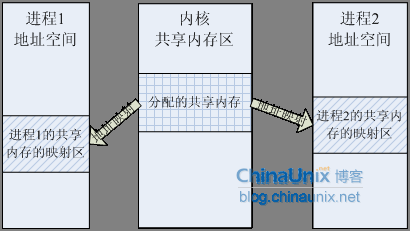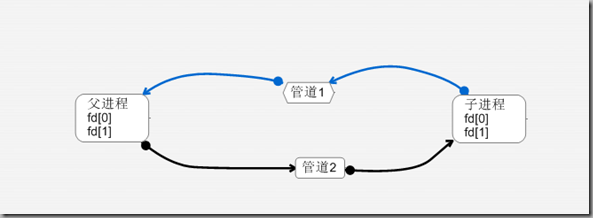20155202 张旭 课下作业: Linux下IPC机制
20155202张旭 Linux下IPC机制
IPC机制定义
在linux下的多个进程间的通信机制叫做IPC(Inter-Process Communication),它是多个进程之间相互沟通的一种方法。在linux下有多种进程间通信的方法:半双工管道、命名管道、消息队列、信号、信号量、共享内存、内存映射文件,套接字等等。使用这些机制可以为linux下的网络服务器开发提供灵活而又坚固的框架。
共享内存

共享内存是在多个进程之间共享内存区域的一种进程间的通信方式,由IPC为进程创建的一个特殊地址范围,它将出现在该进程的地址空间(这里的地址空间具体是哪个地方?)中。其他进程可以将同一段共享内存连接到自己的地址空间中。所有进程都可以访问共享内存中的地址,就好像它们是malloc分配的一样。如果一个进程向共享内存中写入了数据,所做的改动将立刻被其他进程看到。
共享内存是IPC最快捷的方式,因为共享内存方式的通信没有中间过程,而管道、消息队列等方式则是需要将数据通过中间机制进行转换。共享内存方式直接将某段内存段进行映射,多个进程间的共享内存是同一块的物理空间,仅仅映射到各进程的地址不同而已,因此不需要进行复制,可以直接使用此段空间。
注意:共享内存本身并没有同步机制,需要程序员自己控制。
共享内存的实例
int shmget(key_t key,size_t size,int shmflg); //shmget函数用来创建一个新的共享内存段, 或者访问一个现有的共享内存段(不同进程只要key值相同即可访问同一共享内存段)。第一个参数key是ftok生成的键值,第二个参数size为共享内存的大小,第三个参数sem_flags是打开共享内存的方式。
eg.int shmid = shmget(key, 1024, IPC_CREATE | IPC_EXCL | 0666);//第三个参数参考消息队列int msgget(key_t key,int msgflag);
void *shmat(int shm_id,const void *shm_addr,int shmflg); //shmat函数通过shm_id将共享内存连接到进程的地址空间中。第二个参数可以由用户指定共享内存映射到进程空间的地址,shm_addr如果为0,则由内核试着查找一个未映射的区域。返回值为共享内存映射的地址。
eg.char *shms = (char *)shmat(shmid, 0, 0);//shmid由shmget获得
int shmdt(const void *shm_addr); //shmdt函数将共享内存从当前进程中分离。 参数为共享内存映射的地址。
eg.shmdt(shms);
int shmctl(int shm_id,int cmd,struct shmid_ds *buf);//shmctl函数是控制函数,使用方法和消息队列msgctl()函数调用完全类似。参数一shm_id是共享内存的句柄,cmd是向共享内存发送的命令,最后一个参数buf是向共享内存发送命令的参数。
代码练习:
#include <stdio.h>
#include <sys/ipc.h>
#include <sys/shm.h>
#include <sys/types.h>
#include <unistd.h>
#include <string.h>
typedef struct{
char name[8];
int age;
} people;
int main(int argc, char** argv)
{
int shm_id,i;
key_t key;
char temp[8];
people *p_map;
char pathname[30] ;
strcpy(pathname,"/tmp") ;
key = ftok(pathname,0x03);
if(key==-1)
{
perror("ftok error");
return -1;
}
printf("key=%d\n",key) ;
shm_id=shmget(key,4096,IPC_CREAT|IPC_EXCL|0600);
if(shm_id==-1)
{
perror("shmget error");
return -1;
}
printf("shm_id=%d\n", shm_id) ;
p_map=(people*)shmat(shm_id,NULL,0);
memset(temp, 0x00, sizeof(temp)) ;
strcpy(temp,"test") ;
temp[4]='0';
for(i = 0;i<3;i++)
{
temp[4]+=1;
strncpy((p_map+i)->name,temp,5);
(p_map+i)->age=0+i;
}
shmdt(p_map) ;
return 0 ;
}
#include <stdio.h>
#include <string.h>
#include <sys/ipc.h>
#include <sys/shm.h>
#include <sys/types.h>
#include <unistd.h>
typedef struct{
char name[8];
int age;
} people;
int main(int argc, char** argv)
{
int shm_id,i;
key_t key;
people *p_map;
char pathname[30] ;
strcpy(pathname,"/tmp") ;
key = ftok(pathname,0x03);
if(key == -1)
{
perror("ftok error");
return -1;
}
printf("key=%d\n", key) ;
shm_id = shmget(key,0, 0);
if(shm_id == -1)
{
perror("shmget error");
return -1;
}
printf("shm_id=%d\n", shm_id) ;
p_map = (people*)shmat(shm_id,NULL,0);
for(i = 0;i<3;i++)
{
printf( "name:%s\n",(*(p_map+i)).name );
printf( "age %d\n",(*(p_map+i)).age );
}
if(shmdt(p_map) == -1)
{
perror("detach error");
return -1;
}
return 0 ;
}
管道 (PIPE)

管道实际是用于进程间通信的一段共享内存,创建管道的进程称为管道服务器,连接到一个管道的进程为管道客户机。一个进程在向管道写入数据后,另一进程就可以从管道的另一端将其读取出来。
管道的特点:
- 管道是半双工的,数据只能向一个方向流动;需要双方通信时,需要建立起两个管道;
- 只能用于父子进程或者兄弟进程之间(具有亲缘关系的进程)。比如fork或exec创建的新进程,在使用exec创建新进程时,需要将管道的文件描述符作为参数传递给exec创建的新进程。当父进程与使用fork创建的子进程直接通信时,发送数据的进程关闭读端,接受数据的进程关闭写端。
- 单独构成一种独立的文件系统:管道对于管道两端的进程而言,就是一个文件,但它不是普通的文件,它不属于某种文件系统,而是自立门户,单独构成一种文件系统,并且只存在与内存中。
- 数据的读出和写入:一个进程向管道中写的内容被管道另一端的进程读出。写入的内容每次都添加在管道缓冲区的末尾,并且每次都是从缓冲区的头部读出数据。
代码练习:
#include<stdio.h>
#include<unistd.h>
#include<stdlib.h>
#include<string.h>
#include<wait.h>
#include<sys/types.h>
int main(int argc ,char *argv[])
{
int pipefd[2],result;
char buf[1024];
int flag=0;
pid_t pid;
result= pipe(pipefd);//创建一个管道
if(result==-1){
perror("pipe error:");
exit(EXIT_FAILURE);
}
pid=fork();//创建一个子进程
if(pid==-1)
{
perror("fork error:");
exit(EXIT_FAILURE);
}
else if(pid==0){
if((close(pipefd[1]))==-1)//close write only read
{
perror("close write error:");
exit(EXIT_FAILURE);
}
while(1){ //循环读取数据
read(pipefd[0],buf,1024);//最多读取1024个字节
printf("read from pipe : %s\n",buf);
if(strcmp(buf,"quit")==0){// if 读取到的字符串是exit 这是
//父进程会接受到一个终止进程的信号,父进程会回收子进程的资 // 源等
exit(EXIT_SUCCESS);
}
}
}else{
//close read only write
if((close(pipefd[0]))==-1){
perror("close read error:");
exit(EXIT_FAILURE);
}
while(1)//循环写入内容
{
waitpid(pid,NULL,WNOHANG);//等待子进程退出
if(flag==1)
exit(0);
scanf("%s",buf);
write(pipefd[1],buf,strlen(buf)+1);//具体写多少个字节
if(strcmp(buf,"quit")==0){
flag=1;
sleep(1);//让子进程完全退出。
}
}
}
return 1;
}
管道实例:
#include <unistd.h>
int pipe(int file_descriptor[2]);//建立管道,该函数在数组上填上两个新的文件描述符后返回0,失败返回-1。
eg.int fd[2]
int result = pipe(fd);
命名管道(FIFO)
- 命名管道是一种特殊类型的文件,它在系统中以文件形式存在。这样克服了管道的弊端,他可以允许没有亲缘关系的进程间通信。具体操作方法只要创建了一个命名管道然后就可以使用open、read、write等系统调用来操作。创建可以手工创建或者程序中创建。
命名管道实例:
#include <unistd.h>
#include <stdlib.h>
#include <fcntl.h>
#include <limits.h>
#include <sys/types.h>
#include <sys/stat.h>
#include <stdio.h>
#include <string.h>
int main()
{
const char *fifo_name = "/tmp/my_fifo";
int pipe_fd = -1;
int data_fd = -1;
int res = 0;
const int open_mode = O_WRONLY;
int bytes_sent = 0;
char buffer[PIPE_BUF + 1];
if(access(fifo_name, F_OK) == -1)
{
//管道文件不存在
//创建命名管道
res = mkfifo(fifo_name, 0777);
if(res != 0)
{
fprintf(stderr, "Could not create fifo %s\n", fifo_name);
exit(EXIT_FAILURE);
}
}
printf("Process %d opening FIFO O_WRONLY\n", getpid());
//以只写阻塞方式打开FIFO文件,以只读方式打开数据文件
pipe_fd = open(fifo_name, open_mode);
data_fd = open("Data.txt", O_RDONLY);
printf("Process %d result %d\n", getpid(), pipe_fd);
if(pipe_fd != -1)
{
int bytes_read = 0;
//向数据文件读取数据
bytes_read = read(data_fd, buffer, PIPE_BUF);
buffer[bytes_read] = '\0';
while(bytes_read > 0)
{
//向FIFO文件写数据
res = write(pipe_fd, buffer, bytes_read);
if(res == -1)
{
fprintf(stderr, "Write error on pipe\n");
exit(EXIT_FAILURE);
}
//累加写的字节数,并继续读取数据
bytes_sent += res;
bytes_read = read(data_fd, buffer, PIPE_BUF);
buffer[bytes_read] = '\0';
}
close(pipe_fd);
close(data_fd);
}
else
exit(EXIT_FAILURE);
printf("Process %d finished\n", getpid());
exit(EXIT_SUCCESS);
}
#include <sys/types.h>
#include <sys/stat.h>
int mkfifo(const char *filename,mode_t mode); //建立一个名字为filename的命名管道,参数mode为该文件的权限(mode%~umask),若成功则返回0,否则返回-1,错误原因存于errno中。
eg.mkfifo( "/tmp/cmd_pipe", S_IFIFO | 0666 );
int mknod(const char *path, mode_t mode, dev_t dev); //第一个参数表示你要创建的文件的名称,第二个参数表示文件类型,第三个参数表示该文件对应的设备文件的设备号。只有当文件类型为 S_IFCHR 或 S_IFBLK 的时候该文件才有设备号,创建普通文件时传入0即可。
eg.mknod(FIFO_FILE,S_IFIFO|0666,0);
管道和命名管道的区别:
- 对于命名管道FIFO来说,IO操作和普通管道IO操作基本一样,但是两者有一个主要的区别,在命名管道中,管道可以是事先已经创建好的,比如我们在命令行下执行
mkfifo myfifo
#include <unistd.h>
#include <stdlib.h>
#include <stdio.h>
#include <fcntl.h>
#include <sys/types.h>
#include <sys/stat.h>
#include <limits.h>
#include <string.h>
int main()
{
const char *fifo_name = "/tmp/my_fifo";
int pipe_fd = -1;
int data_fd = -1;
int res = 0;
int open_mode = O_RDONLY;
char buffer[PIPE_BUF + 1];
int bytes_read = 0;
int bytes_write = 0;
//清空缓冲数组
memset(buffer, '\0', sizeof(buffer));
printf("Process %d opening FIFO O_RDONLY\n", getpid());
//以只读阻塞方式打开管道文件,注意与fifowrite.c文件中的FIFO同名
pipe_fd = open(fifo_name, open_mode);
//以只写方式创建保存数据的文件
data_fd = open("DataFormFIFO.txt", O_WRONLY|O_CREAT, 0644);
printf("Process %d result %d\n",getpid(), pipe_fd);
if(pipe_fd != -1)
{
do
{
//读取FIFO中的数据,并把它保存在文件DataFormFIFO.txt文件中
res = read(pipe_fd, buffer, PIPE_BUF);
bytes_write = write(data_fd, buffer, res);
bytes_read += res;
}while(res > 0);
close(pipe_fd);
close(data_fd);
}
else
exit(EXIT_FAILURE);
printf("Process %d finished, %d bytes read\n", getpid(), bytes_read);
exit(EXIT_SUCCESS);
}
就是创建一个命名通道,我们必须用open函数来显示地建立连接到管道的通道,而在管道中,管道已经在主进程里创建好了,然后在fork时直接复制相关数据或者是用exec创建的新进程时把管道的文件描述符当参数传递进去。
- 一般来说FIFO和PIPE一样总是处于阻塞状态。也就是说如果命名管道FIFO打开时设置了读权限,则读进程将一直阻塞,一直到其他进程打开该FIFO并向管道写入数据。这个阻塞动作反过来也是成立的。如果不希望命名管道操作的时候发生阻塞,可以在open的时候使用O_NONBLOCK标志,以关闭默认的阻塞操作。
信号 (signal)
- 信号机制是unix系统中最为古老的进程之间的通信机制,用于一个或几个进程之间传递异步信号。信号可以有各种异步事件产生,比如键盘中断等。shell也可以使用信号将作业控制命令传递给它的子进程。
信号实例
int kill(pid_t pid,int sig); //kill函数向进程号为pid的进程发送信号,信号值为sig。当pid为0时,向当前系统的所有进程发送信号sig。
int raise(int sig);//向当前进程中自举一个信号sig, 即向当前进程发送信号。
include <unistd.h>
unsigned int alarm(unsigned int seconds); //alarm()用来设置信号SIGALRM在经过参数seconds指定的秒数后传送给目前的进程。如果参数seconds为0,则之前设置的闹钟会被取消,并将剩下的时间返回。使用alarm函数的时候要注意alarm函数的覆盖性,即在一个进程中采用一次alarm函数则该进程之前的alarm函数将失效。
int pause(void); //使调用进程(或线程)睡眠状态,直到接收到信号,要么终止,或导致它调用一个信号捕获函数。
##### 代码:
#include <stdio.h>
#include <sys/types.h>
#include <stdlib.h>
#include <signal.h>
int main()
{
char buffer[100];
struct sigaction act;
if(sigaction(SIGINT,&act, NULL) == -1)
{
printf("sigaction error exit now\n");
exit(0);
}
while(1)
{
fgets(buffer,sizeof(buffer),stdin);
printf("%s\n",buffer);
}
return 0;
}
消息队列
- 消息队列是内核地址空间中的内部链表,通过linux内核在各个进程直接传递内容,消息顺序地发送到消息队列中,并以几种不同的方式从队列中获得,每个消息队列可以用IPC标识符唯一地进行识别。内核中的消息队列是通过IPC的标识符来区别,不同的消息队列直接是相互独立的。每个消息队列中的消息,又构成一个独立的链表。
消息队列克服了信号承载信息量少,管道只能承载无格式字符流。
消息队列的本质
- Linux的消息队列(queue)实质上是一个链表,它有消息队列标识符(queue ID)。 msgget创建一个新队列或打开一个存在的队列;msgsnd向队列末端添加一条新消息;msgrcv从队列中取消息, 取消息是不一定遵循先进先出的, 也可以按消息的类型字段取消息。
消息队列与命名管道的比较
- 消息队列跟命名管道有不少的相同之处,通过与命名管道一样,消息队列进行通信的进程可以是不相关的进程,同时它们都是通过发送和接收的方式来传递数据的。在命名管道中,发送数据用write,接收数据用read,则在消息队列中,发送数据用msgsnd,接收数据用msgrcv。而且它们对每个数据都有一个最大长度的限制。
- 与命名管道相比,消息队列的优势在于,1、消息队列也可以独立于发送和接收进程而存在,从而消除了在同步命名管道的打开和关闭时可能产生的困难。2、同时通过发送消息还可以避免命名管道的同步和阻塞问题,不需要由进程自己来提供同步方法。3、接收程序可以通过消息类型有选择地接收数据,而不是像命名管道中那样,只能默认地接收。
- 消息队列头文件:
#include <sys/types.h>
#include <sys/stat.h>
#include <sys/msg.h>
- 1、消息缓冲区结构:
struct msgbuf{
long mtype;
char mtext[1];//柔性数组
}
- 在结构中有两个成员,mtype为消息类型,用户可以给某个消息设定一个类型,可以在消息队列中正确地发送和接受自己的消息。mtext为消息数据,采用柔性数组,用户可以重新定义msgbuf结构。例如:
struct msgbuf{
long mtype;
char mtext[1];//柔性数组
}
- 当然用户不可随意定义msgbuf结构,因为在linux中消息的大小是有限制的,在linux/msg.h中定义如下:
define MSGMAX 8192
消息总的大小不能超过8192个字节,包括mtype成员(4个字节)。
- 2、ipc_perm内核数据结构:结构体ipc_perm保存着消息队列的一些重要的信息,比如说消息队列关联的键值,消息队列的用户id组id等。它定义在头文件linux/ipc.h中。
struct ipc_perm{
key_t key;
uid_t uid;
gid_t gid;
.......
};
代码:
#include<stdio.h>
#include<stdlib.h>
#include<sys/msg.h>
#include<string.h>
#include<unistd.h>
#define MAX_TEXT 1024
#define MSG_SIZE 512
struct msg_st{
long int msg_type; //消息类型
char text[MAX_TEXT];//消息内容
};
int main()
{
struct msg_st data;
char buf[MSG_SIZE];
int msgid=msgget((key_t)2456,0666|IPC_CREAT);
if(msgid==-1){
perror("msgget");
exit(1);
}
while(1){
printf("接收:");
if(msgrcv(msgid,(void*)&data,MAX_TEXT,1,0)==-1){
perror("msgrcv");
exit(2);
}
printf("%s\n",data.text);
}
return 0;
}
#include<stdio.h>
#include<sys/ipc.h>
#include<stdlib.h>
#include<sys/types.h>
#include<sys/msg.h>
#include<unistd.h>
#include<string.h>
#define MAX_TEXT 512
#define MSG_SIZE 512
struct msg_st
{
long int msg_type; //消息类型
char text[MAX_TEXT];//消息内容
};
int main()
{
struct msg_st data;
char buf[MSG_SIZE];
//创建消息队列
int msgid=msgget((key_t)2456,0666|IPC_CREAT);
if(msgid==-1)
{
perror("msgget");
exit(1);
}
printf("消息队列创建成功\n");
//发送消息
while(1)
{
//从键盘输入发送的消息
printf("发送:");
fgets(buf,MSG_SIZE,stdin);
data.msg_type=1;
strcpy(data.text,buf);
//将消息发送到消息队列
if(msgsnd(msgid,(void*)&data,MAX_TEXT,0)==-1){
perror("msgsnd");
exit(1);
}
}
return 0;
}
消息队列、信号量以及共享内存的相似之处:
它们被统称为XSI IPC,它们在内核中有相似的IPC结构(消息队列的msgid_ds,信号量的semid_ds,共享内存的shmid_ds),而且都用一个非负整数的标识符加以引用(消息队列的msg_id,信号量的sem_id,共享内存的shm_id,分别通过msgget、semget以及shmget获得),标志符是IPC对象的内部名,每个IPC对象都有一个键(key_t key)相关联,将这个键作为该对象的外部名。
20155202 张旭 课下作业: Linux下IPC机制的更多相关文章
- 请问下./在Linux下是什么意思
请问下./在Linux下是什么意思 http://zhidao.baidu.com/link?url=1f-80KN7cdi-7XECpwXLUn6Ps4reMBL2zB6eiDk7JliwDgW6k ...
- Windows10下配置Linux下C语言开发环境
今天为大家介绍如在Windows10下配置Linux下C语言开发环境,首先安装linux子系统:启用开发者模式 1.打开设置 2.点击更新和安全3.点击开发者选项 4.启用开发人员模式 5.更改系统功 ...
- linux各种IPC机制(进程通信)
linux各种IPC机制 (2011-07-08 16:58:35) 原文地址:linux各种IPC机制(转)作者:jianpengliu 原帖发表在IBM的developerworks网站 ...
- [转帖]linux各种IPC机制
linux各种IPC机制 docker中的资源隔离,一种就是IPC的隔离.IPC是进程间通信. 下面的文章转载自https://blog.csdn.net/yyq_9623/article/detai ...
- windows下与linux下安装redis及redis扩展
1. Redis的介绍 Redis是一个开源的使用ANSI C语言编写.支持网络.可基于内存亦可持久化的日志型.Key-Value数据库,并提供多种语言的API.从2010年3月15日起 ...
- Windows下与Linux下编写socket程序的区别 《转载》
原文网址:http://blog.chinaunix.net/uid-2270658-id-308160.html [[Windows]] [Windows: 头文件的区别] #include< ...
- python安装MySQLdb:在windows下或linux下(以及eclipse中pydev使用msqldb的配置方法)
写的非常好,可以解决问题: windows下:http://blog.csdn.net/wklken/article/details/7253245 linux下:http://blog.csdn.n ...
- windows下类似Linux下的grep命令
今天要查看windws下代理服务器有哪些IP连接过来,但使用 netstat -na 后出现很多连接会话,不方便查看. 想到Linux下的grep非常方便,于是网络上搜寻,还是有类似的命令findst ...
- linux各种IPC机制
docker中的资源隔离,一种就是IPC的隔离.IPC是进程间通信. 下面的文章转载自https://blog.csdn.net/yyq_9623/article/details/78794775 原 ...
随机推荐
- Nginx 配置多站点vhost
假设你想在Linux Nginx中用不同的域名访问不同的目录,这时就要配置多个vhost,具体配置如下,假设网站根目录设定在/var/www/ 1.在/var/www/下新建两个目录 /var/www ...
- Oracle EBS 查询物料报错
- C++虚函数原理
类中的成员函数分为静态成员函数和非静态成员函数,而非静态成员函数又分为普通函数和虚函数. Q: 为什么使用虚函数 A: 使用虚函数,我们可以获得良好的可扩展性.在一个设计比较好的面向对象程序中,大多数 ...
- asp.net 一般处理程序实现网站验证码
使用VerifyCode.ashx一般处理程序生成验证码,实现如下: using System; using System.Drawing; using System.Web; using Syste ...
- 关于springMVC的一些xml配置
①springMVC必备jar包: commons-logging-1.1.3.jar spring-aop-4.0.0.RELEASE.jar spring-beans-4.0.0.RELEASE. ...
- RAC性能分析 - gc buffer busy acquire 等待事件
概述---------------------gc buffer busy是RAC数据库中常见的等待事件,11g开始gc buffer busy分为gc buffer busy acquire和gc ...
- 第一个 mac 程序 Create-JSON-Model
第一个 mac 程序 Create-JSON-Model 效果图 数据 {"ID":null,"name":"Doe","firs ...
- .net mvc Html.DropDownListFor 设置默认值无效
错误描述: 控制器部分: //从数据字典中加载下拉框 (使用DropDownListFor,SelectList 中不需要设置选中值,即便设置了选中值,也会优先读取Model中对应的值) ViewBa ...
- 一、Linux中的常用命令2 二、Vim编辑器的使用
一.Linux的常用命令###<1>文件目录操作 13. echo:用于输出字符串,shell编程,echo 1. 输出字符串 : echo str ,shell编程会使用(类似java中 ...
- map filter 的func 放在前面
map filter 的func 放在前面 sorted 在后 ( iter.. , key=function')



